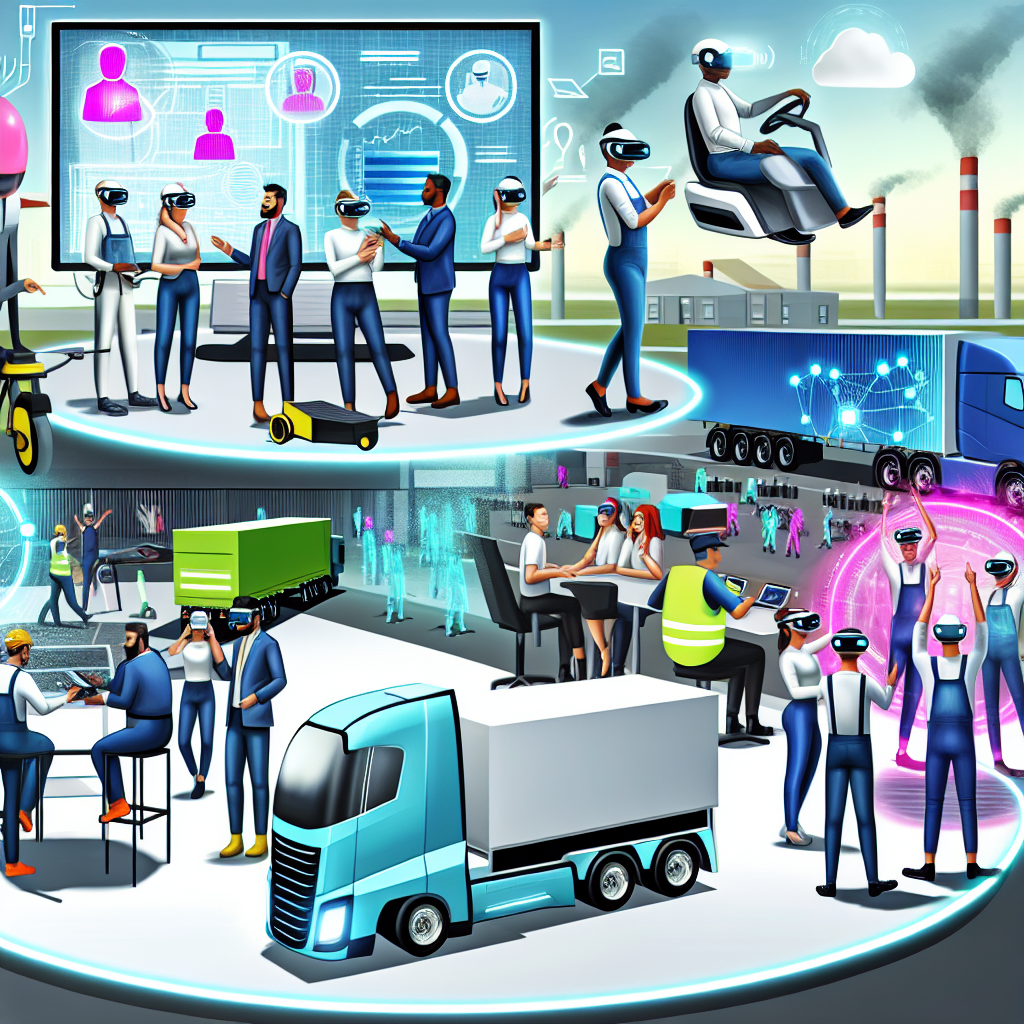In the ever-evolving trucking industry, the dual forces of digitalization and workforce investment are not just trends but necessities for success. As technology reshapes operational landscapes, striking a balance between investing in cutting-edge digital tools and nurturing a skilled workforce becomes crucial.
David Kelly, president of Innocon, believes that understanding customer preferences is key, stating,
“Some just don’t want to use digital tools.”
Such insights reveal that while innovation is imperative, the human element remains indispensable. This interplay between technology and personnel is vital for establishing resilience and competitiveness in an industry facing challenges and opportunities alike.
As Shannon Newton, president of the Arkansas Trucking Association, aptly points out,
“We’re looking at re-investment in people, both drivers and office staff, on trying to maintain and attract good talent to our industry.”
Therefore, a strategic approach to the investment in people in the trucking industry is essential to harness the benefits of digital advancements while catering to the workforce’s needs.
Investing in People: Embracing People-First Strategies in the Trucking Industry
In recent years, the trucking industry has encountered a variety of challenges, from driver shortages to the increasing reliance on technology. As companies seek to navigate this landscape, the concept of investment in people, particularly through people-first strategies, has emerged as an essential approach. These strategies emphasize understanding the needs and well-being of employees, recognizing that a satisfied workforce is critical to achieving operational success. Moreover, workforce engagement in trucking plays a vital role in enhancing productivity and retention rates among employees.
Industry leaders like David Kelly, the president of Innocon, underscore the importance of blending technological advancements with human interaction. After launching an online ordering platform, Kelly noted that over 30% of customers still preferred traditional phone communication. This highlights the necessity for trucking firms to not only adopt digital tools but also to maintain a strong focus on personal relationships. Kelly stated, “You have to look after the entire customer base,” reflecting the need for a holistic approach to client relations that values both people and technology.
Similarly, Jason Belgrave, a prominent figure in the industry, points out that “If change fails, it is often because people have not been prepared properly.” This insight stresses the importance of comprehensive training and engagement initiatives that equip employees to handle shifts in technology and operations effectively.
Case Studies: Successful People-First Strategies
Numerous companies in the trucking sector have successfully implemented people-first strategies, demonstrating that investing in employees yields substantial benefits:
- R.E. Garrison Trucking: After centralizing their recruitment efforts, they noted a 100% increase in hiring and a significant reduction in marketing costs. By fostering a driver-first culture, they transformed into a desirable employer, resulting in a waiting list of qualified drivers.
Learn more about R.E. Garrison - Stokes Trucking: By adopting a people-centric approach, Stokes Trucking abolished their advertising budget completely, achieving a turnover rate of only 5.8%. Their efforts to create an appreciative culture ensured that drivers felt valued every day.
Learn more about Stokes Trucking - Walmart: The company rolled out multiple initiatives, including custom driver workflow applications and increased driver compensation. Their commitment to safety and satisfaction earned them accolades for their fleet management practices in 2023.
Learn more about Walmart’s initiatives - Nussbaum Transportation: Moving away from outdated recruitment systems allowed Nussbaum to streamline hiring and enhance communication with potential hires, resulting in significant cost savings and a more efficient workforce.
Learn more about Nussbaum
The Value of Investing in People
The importance of investing in people is underscored by several statistics:
- Over 58% of trucking companies have increased their investment in workforce upskilling in the past two years.
- Companies focusing on reskilling have seen a 20% reduction in driver turnover rates.
- A significant 72% of fleet managers assert that continuous upskilling is vital for adapting to technological changes.
Explore workforce statistics
In summary, prioritizing people-first strategies in the trucking sector is not just a trend; it is a transformative approach that fosters employee satisfaction, operational efficiency, and long-term growth. As the industry continues to evolve, the focus on valuing people will remain central to successful fleet management.
Freight Market Analysis: Workforce Implications and Future Driver Shortage
The freight industry currently faces a critical challenge with an acute driver shortage that not only affects operational efficiency but also presents substantial economic consequences. As identified by the American Trucking Associations (ATA), an estimated shortage of approximately 60,000 drivers exists as of 2023, influenced by an aging workforce and the often unfavorable working conditions associated with truck driving. This shortfall translates to a staggering loss of about $95.5 million weekly across the industry, pointing to an urgent need for solutions [CCJ Digital].
The reasons behind this imminent crisis are multifaceted. An older demographic of existing drivers is retiring, while new entrants into the field are insufficient to replace them. Furthermore, the nature of the trucking job—long hours away from home, demanding schedules, and an increasingly stringent regulatory environment—disincentivizes many potential candidates. Addressing these issues is essential, as the industry could potentially generate an additional $47.4 billion in revenue if the driver shortage is resolved [CCJ Digital].
Amidst these challenges, automation is emerging as both a potential remedy and a source of concern within the freight market. The integration of autonomous vehicles promises to alleviate some workforce pressures, with companies beginning to deploy driverless trucks in specific corridors, such as the 200-mile stretch between Dallas and Houston [Axios]. While these advancements can improve efficiency and reduce labor costs, the introduction of automation raises important questions about job displacement for human drivers and safety regulations. The Owner-Operator Independent Drivers Association (OOIDA) expresses skepticism regarding the feasibility of fully autonomous trucks in the absence of comprehensive federal guidelines [Axios].
Ultimately, balancing the benefits of technological advancements with the necessity of workforce retention and training will be crucial. Many industry leaders assert that investments must be made not only in automation but also in the workforce itself. Strategies such as enhancing employee onboarding programs, increasing compensation, and fostering a supportive company culture can help bridge the gap caused by labor shortages. Addressing both technological integration and workforce wellbeing will be paramount for sustaining operational efficiency and mitigating the looming driver crisis in the freight industry.
Comparison of Digital Technologies and People Strategies in Trucking Companies
| Company | Digital Technologies Adopted | Investment in People Strategies |
|---|---|---|
| Innocon | Online ordering platform, Customer Relationship Management (CRM) | Comprehensive training programs |
| TFI | Fleet telematics, Route optimization software | Leadership development programs |
| Purolator | VR training programs, Automated parcel tracking | Employee wellness initiatives |
| Preferred Towing | GPS fleet management, Mobile workforce applications | Competitive compensation packages |
This table showcases the diverse approaches taken by different trucking companies regarding their investment in digital technologies and workforce development. It is clear that the trucking industry is recognizing the importance of both digital innovation and investing in people strategies to enhance their operations and employee satisfaction.
Truck Driver Absenteeism and Generational Differences in Workplace Attitudes
The trucking industry is currently grappling with significant challenges related to absenteeism and generational changes among its workforce. While exact absenteeism rates are elusive, research suggests that adverse events, such as equipment malfunctions, can inadvertently strengthen employee bonds and commitment. Such findings highlight the necessity of effective management strategies to address absenteeism proactively, as unresolved issues could escalate operational difficulties.
As generational shifts occur, the values and preferences of Millennials and Generation Z drivers become increasingly significant. These younger employees prioritize work-life balance, flexibility, and a commitment to technological integration. For instance, they seek employers who provide constant feedback and opportunities for both personal and professional growth. Furthermore, Generation Z members, being digital natives, not only expect modern communication tools but also appreciate organizations that are socially responsible and inclusive.
The implication for workforce management is clear: companies that adapt to these changing attitudes by offering flexible work arrangements, investing in advanced technologies, and fostering an inclusive company culture will likely experience higher employee satisfaction and lower absenteeism rates. Adopting a people-first approach ensures that companies within the trucking industry can attract and retain the best talent, addressing the critical issue of driver shortages that threatens operational efficiency.
In summary, understanding the dynamics of absenteeism alongside generational differences is crucial for effective workforce management in the trucking sector. By investing in their workforce and being responsive to employee needs, trucking companies can better equip themselves to navigate the challenges ahead while enhancing their overall performance and sustainability.
The Role of AI and Automation in Managing Workforce Challenges in the Trucking Industry
Artificial intelligence (AI) and automation are increasingly integral to workforce management in the trucking industry, offering numerous advantages while also presenting certain challenges.
Current Role of AI and Automation in Workforce Management:
- Route Optimization: AI algorithms analyze traffic patterns and weather conditions to determine the most efficient routes, reducing delivery times by up to 20% and decreasing fuel consumption by approximately 10-15%.
- Predictive Maintenance: AI systems monitor vehicle performance in real-time, predicting maintenance needs and reducing truck breakdowns by up to 30%.
- Driver Monitoring and Safety: AI-powered systems detect driver fatigue and unsafe behaviors, leading to a 25% reduction in fatigue-related incidents.
- Load Matching and Scheduling: AI platforms enhance load matching efficiency by 25%, optimizing fleet utilization and reducing idle times.
Pros of AI and Automation in Workforce Management:
- Increased Efficiency: AI-driven route optimization and load matching improve delivery times and reduce fuel costs, enhancing overall operational efficiency.
- Enhanced Safety: AI-based safety systems have reduced accidents involving autonomous trucks by 15% in pilot tests, contributing to safer roadways.
- Cost Savings: Predictive maintenance powered by AI can reduce truck breakdowns by up to 30%, leading to significant cost savings.
- Improved Driver Retention: AI contributes significantly to driver retention by improving work conditions, with 55% of trucking companies reporting positive impacts.
Cons of AI and Automation in Workforce Management:
- Job Displacement: The adoption of autonomous trucks raises concerns about potential job losses for drivers, as automation may reduce the need for human operators.
- Technical Challenges: Integrating AI systems requires significant technological adaptation and investment, posing challenges for some companies.
- Regulatory and Liability Issues: The deployment of autonomous trucks introduces complexities in determining liability in the event of accidents, as well as navigating varying regulations across jurisdictions.
Recent Examples and Statistics:
- Adoption Rates: 65% of trucking companies in the U.S. have adopted some form of AI technology, indicating widespread acceptance of AI in the industry.
- Market Growth: The global AI in transportation market is projected to reach $10 billion by 2028, reflecting significant investment and growth in AI applications within the trucking sector.
- Operational Improvements: 80% of trucking companies using AI report increased operational efficiency, highlighting the tangible benefits of AI integration.
- Safety Enhancements: AI-driven safety systems have reduced accidents involving autonomous trucks by 15% in pilot tests, demonstrating the potential for improved safety outcomes.
In summary, AI and automation are transforming workforce management in the trucking industry by enhancing efficiency, safety, and cost-effectiveness. However, these advancements also necessitate careful consideration of potential job displacement, technical integration challenges, and regulatory complexities.
In conclusion, the future of the trucking industry hinges on a balanced strategy that prioritizes both digital innovation and investment in people. As we’ve explored, the challenges ranging from driver shortages to changing workforce attitudes cannot be solved by technology alone. Embracing people-first strategies is essential not only for operational success but also for fostering a work environment where employees feel valued and engaged.
It is crucial for organizations to reflect on how they can adopt this balanced approach, ensuring that technological advancements enhance rather than replace human interactions. By investing in people, understanding their needs, and integrating digital tools thoughtfully, the trucking industry can navigate the complexities of the modern market and emerge more resilient than ever. Let us commit to paving the way for a future where technology and humanity drive success together.


Cross-Training Strategies: Enhancing Workforce Adaptability in Trucking
In the trucking industry, cross-training strategies are crucial for fostering flexibility among workers and ensuring they are prepared to handle a variety of tasks. This adaptability is vital as companies continuously face dynamic operational demands and workforce shortages.
Utilizing VR for Efficient Training
A prime example of innovation in training is the use of Virtual Reality (VR) at Purolator, where VR technologies have reduced training time from weeks to just hours. This leap in efficiency allows employees to engage in risk-free simulations, enhancing their skill acquisition and overall confidence. Studies indicate that VR training can boost retention rates up to 75%—a significant improvement compared to traditional methods, which yield retention rates between 10% and 30%. The deployment of VR not only expedites the learning process but also prepares employees for real-world scenarios in a safe environment, ultimately promoting a safer workplace.
Generational Differences Impacting Training
As the workforce becomes increasingly generationally diverse, understanding the unique learning preferences of different age groups is essential. Baby Boomers often favor structured, instructor-led training, while Generation X is more inclined toward self-directed learning. Millennials and Generation Z, conversely, thrive in interactive and technology-driven environments; they seek training that offers immediate feedback and aligns with their digital experiences. Recognizing these preferences allows trucking companies to tailor their training programs, fostering an inclusive atmosphere that maximizes employee engagement and adaptability.
Conclusion
By integrating VR training methods and adapting to generational differences, the trucking industry can significantly enhance workforce adaptability. Such investments not only prepare teams for varied operational roles but also contribute to overall safety and efficiency, addressing critical labor challenges in this evolving sector.
References:
- VR Cross-Training in the Workplace: Boost Skills Now
- Transformative Impact of VR on Supply Chain Management and Training
- Generational Learners: Preferences? Motivators? Differences?
- How Generational Differences in the Workplace Impact Learning
- Four Generations, One Workforce: Can Your Training Speak to All of Them?

Truck Driver Retention Strategies
In reviewing the trucking industry’s ongoing challenges, implementing effective driver retention strategies is paramount. Key approaches include:
- Competitive Compensation and Benefits: Offering fair wages, comprehensive health insurance, and retirement plans demonstrates value for drivers’ contributions. Surveys indicate that concerns over meeting monthly bills are prevalent among drivers, emphasizing the need for competitive pay structures. (Refer to Omnitracs)
- Flexible Scheduling and Work-Life Balance: Providing predictable routes and flexible schedules allows drivers to spend more time at home, addressing common concerns about work-life balance. Implementing options like “home daily” or “home weekly” routes can significantly improve job satisfaction. (Explore further at FarEye)
- Career Development Opportunities: Investing in continuous training, skill development programs, and clear career paths shows commitment to drivers’ professional growth, leading to higher job satisfaction and retention. (Learn more from Peach State Truck Centers)
- Modern Equipment and Technology: Equipping vehicles with advanced safety features and maintaining high safety standards not only ensures driver safety but also boosts morale and reduces downtime. (Uptake)
- Recognition and Appreciation: Regularly acknowledging drivers’ accomplishments, such as safe driving records and years of service, fosters a sense of belonging and motivation. Implementing recognition programs can significantly boost morale and loyalty. (Lytx)
- Open Communication and Feedback: Maintaining regular communication with drivers, offering feedback, and listening to their concerns helps build trust and a positive work environment. Establishing driver councils or feedback systems can provide valuable insights into areas for improvement. (Lytx)
- Health and Wellness Programs: Creating a supportive work environment with access to health and wellness programs, counseling services, and a sense of community among drivers can significantly improve their job satisfaction and overall well-being. (Peach State Truck Centers)
By implementing these driver retention strategies, trucking companies can enhance driver satisfaction, reduce turnover, and ultimately improve operational efficiency.
As the trucking industry grapples with pressing issues stemming from a driver shortage, it becomes increasingly clear that relying solely on technological solutions is insufficient. While the integration of automation and digital tools provides promising enhancements, it is the synergy of technology and a well-prepared workforce that will truly define future success in the freight market. Addressing both these elements is essential not only for maintaining operational efficiency but also for fostering a sustainable business model that prioritizes employee retention and satisfaction.
In the search for effective strategies that combine these dual objectives, it is pivotal to evaluate how leading companies in the industry have approached this balance. The following comparison highlights the varied commitments made by trucking organizations towards digital innovation and the simultaneous investment in their workforce, showcasing that a holistic approach is necessary for navigating the challenges ahead.
